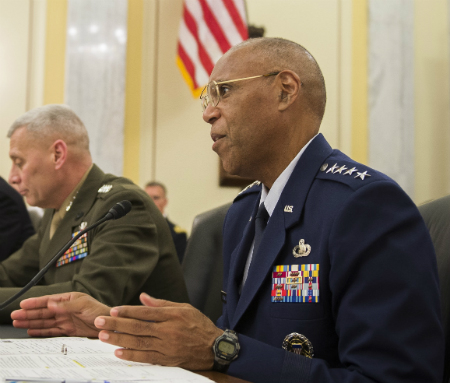 The Air Force’s civilian workforce is so crucial to the service’s day-to-day functioning that it can’t be separated out when discussing readiness issues, Air Force Vice Chief of Staff Gen. Larry Spencer told lawmakers. “I don’t [make] a distinction between civilian airmen and readiness because they are so key to readiness,” he told the Senate Armed Services Committee’s readiness panel on April 18. Spencer noted that some 80 percent to 90 percent of the service’s civilian employees “don’t work in the Pentagon.” Instead, “They work out in the field. And I’m not sure everybody quite understands that,” he said. He cited the critical role of civilian mechanics in Air Force pilot training. At Laughlin AFB, Tex., for example, civilians perform “100 percent of the maintenance” on the airplanes there, he said. Thus, a furlough of Defense Department civilians—which the Pentagon is facing due to the budget sequester—would mean “a direct cut to the amount of airplanes” available for that training and “the amount of pilots we can train,” said Spencer. (Spencer’s prepared statement)
The Air Force’s civilian workforce is so crucial to the service’s day-to-day functioning that it can’t be separated out when discussing readiness issues, Air Force Vice Chief of Staff Gen. Larry Spencer told lawmakers. “I don’t [make] a distinction between civilian airmen and readiness because they are so key to readiness,” he told the Senate Armed Services Committee’s readiness panel on April 18. Spencer noted that some 80 percent to 90 percent of the service’s civilian employees “don’t work in the Pentagon.” Instead, “They work out in the field. And I’m not sure everybody quite understands that,” he said. He cited the critical role of civilian mechanics in Air Force pilot training. At Laughlin AFB, Tex., for example, civilians perform “100 percent of the maintenance” on the airplanes there, he said. Thus, a furlough of Defense Department civilians—which the Pentagon is facing due to the budget sequester—would mean “a direct cut to the amount of airplanes” available for that training and “the amount of pilots we can train,” said Spencer. (Spencer’s prepared statement)
2026 NDAA: 5 Highlights for Airmen and Guardians
Dec. 18, 2025
President Donald Trump signed the 2026 National Defense Authorization Act on Dec. 18, a day after Congress passed the annual defense policy bill for the 65th consecutive year. Here’s what it means for the Air Force and Space Force.

